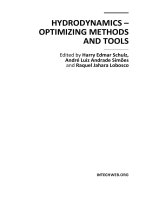Hydrodynamics Optimizing Methods and Tools Part 15 potx
Bạn đang xem bản rút gọn của tài liệu. Xem và tải ngay bản đầy đủ của tài liệu tại đây (593.28 KB, 14 trang )
Hydrodynamics – Optimizing Methods and Tools
408
The velocity field u
i
(x) in the convective term is known from the flow equation. The
transport of species in the liquid should be referred to the velocity
f
i
ux
()
()
of a primary
phase, which carries the species. Since the gas density is small, the velocity
f
i
ux
()
()
is close
to the centre of mass velocity in a mixture.
3. Further simplification, adaptation and verification of the integrated model
The equations presented above are well known and widely used. For real application of
them to VAE the source/sink terms, coefficients, and boundary conditions should be
specified. For the sake of effective solution of these conjugative equations some
simplifications should be done. Some of them are discussed below. The possibilities of the
simplifications are to be checked by verification and validation of the numerical models.
3.1 Some features of heatmass transfer in horizontal and vertical AEs
The thermal regime of AE installations can be characterized by the averaged volumetric heat
generation per unit volume
f
AA
p
A
p
SWV/
, where
Ap
W
is the total heat generation in the
cell,
Ap
V
is the estimated heated volume. As it was mentioned, vertical AEs may have the
parameter
f
A
S
some times greater than that of horizontal AEs. The reason is in their
geometry as it can be seen from Fig.1: considerable volume of the horizontal AE is occupied
by the electrodes and electrolyte lying out of working space. The heat scattering in
horizontal AEs is successfully calculated with use of common heat conductivity equation,
the areas of the electrolyte flow are taken into account in such a simulations through
effective heat conductivity coefficients. Since the working space in horizontal AE is situated
downward, the alumina granules being introduced in the electrolyte dissolute near the
bottom and reach the working space without considerable problems.
In vertical AEs the
f
A
S
parameter is larger since the working space occupies relatively
larger volume. The dominant physical process in heat removal is the convection. Let's
compare the mass flow rates resulting from the natural convection and from bubble driven
forces. The cause of the motion in both cases may be characterized as an averaged density
gradient in mixture. In case of natural convection in a single-phase liquid the gradient arises
due to thermal expansion and nonuniform composition. The latter factor gives the relative
density variation
less than
2
10
(taking into account that variations of alumina
concentration in working space are normally not much greater than 2%). Assumed
temperature drops in working space shouldn't be greater than
T~100K
, heat expansion
coefficient
4
0.5 10
K
1
, thermal volumetric deformation: T~
2
10
, the volumetric
buoyancy force:
T
fgT+)
0
~(
.
The averaged buoyancy force involved with presence of the gas bubbles is
G
fg
0
~
.
Usually gas volume fraction
has an order of 0.1, i.e. in that case we have
GT
ff
. Hence,
in working space bubble driven (drag) force should dominate and mainly defines the flow at
the installation. This allows some roughness in determination of the density through the
temperature and composition, but requires to pay larger attention to modeling of interfacial
momentum exchange, namely to drag force.
Hydrodynamical Simulation of Perspective Installations for Electrometallurgy of Aluminium
409
3.2 Simplifications in multiphase model
The gas flow at the lowest part of vertical electrolytic cell consists of separate bubbles, gas
volume fraction through the width of the gap is relatively small. The problem of description
of a dispersed bubble flows in the vertical gap is satisfactory studied to this day for
monodisperse bubble flow with 0.1 0.2
. There exists several models for polydisperse
flows (see, for example (Krepper et al., 2007), (Silva & Lage, 2011), (Guan Heng Yeoh &
Jiyuan Tu, 2010). Since the gas volume fraction in VAE may amount to the values of some
tens percents, the bubble flow in the vertical working space may be really polydisperse due
to various departure diameters and coalescence as it is sketched in Fig.5.
Fig. 5. Bubble accumulation and evolution.
The implementation of the model of polydispersity in the whole numerical model of VAE
will result in the increasing of the number of equations, because several additional
equations will be added, which describe the introduced size ranked groups of bubbles
(usually
34 or more). We should add the model of coalescence, probability density
function (PDF) for bubble diameters. These equations and models require the experimental
data, which for bubbles in cryolite are rather poor. The result of the such sophistication will
be in an improvement of the model of dispersed bubble flow for the range of gas volume
fraction of the order of 0.1-0.2. For higher volume fraction the applied MCFD methods will
be essentially phenomenological, and here we have the common dilemma: before the
implementation of a new improved approach the researcher should decide whether the
improvement be really reached and what is the calculation cost of the work.
Because of complexity of the full numerical model of VAEs and the lack of the experimental
data the models of polydispersity were not considered for them by authors. In all
simulations the bubble size was taken as an averaged value, which may be varied during
serial quality assurance calculations. The effects of the variable bubble size in a working
space may be investigated numerically as a separate effects and be taken into account
through the model coefficients.
Another important question to MCFD model concerns with the above mentioned body
bubble forces. They influence the distribution of
across the vertical gap, that defines the
cross profile of vertical component of a velocity and in somewhat may effect the mass flow
Hydrodynamics – Optimizing Methods and Tools
410
rate in the interelectrode gap. There exists several forms of equations for the lift force (see
Antal et al., 1991, Legendre & Magnaudet, 1998), which were validated and used by many
authors. The testing and identification of the models of the lift force and wall force (Antal et al.,
1991, Lopez de Bertodano, 1994, Troshko & Hassan, 2001), which prevents from the bubbles
reattachment, is usually performed in the bubble column with downward bubble injection.
Air
water flows are commonly considered in such experiments. The analogous experiments
for wall generation of the bubbles in fused cryolite are unknown to authors. The experience
shows that implementation of new correlations in multiphase models always requires some
fitting of the coefficients during the model verification. Since the using of lift force model in
common form often reduces the stability of numerical calculations, more simple form of
horizontal component force was taken for simulation of bubble motion across the gap. The
robustness of simulations is an argument to develop and use the simplified “engineering
level” models, which have to be tested and studied for prototypical conditions.
Another argument to use the simplified form for simulation of the bubble body force is in the
above mentioned relatively small established range of the validity of disperse models. The
experiments with bubble flows are conducted usually for air
water mixtures in conditions
of clean and even walls of bubble columns and low gas volume fractions. In conditions of
the aluminium reduction cell the wall roughness, the bubble size and gas volume fraction
are usually relatively high, and the model validated on the water experiments may be
incorrect in the conditions of VAE working space.
Fig. 6. To introduction of effective force.
In the experiments with vertical wall gas generations (see, for example, Cheung & Epstein,
1987, Ziegler & Evans, 1986) the average thickness of the near-wall bubble layer increases
with the height. The proposed phenomenology takes into account only this fact. An effective
body force is introduced for the gas phase, it acts in the secondary phase normally to wall, in
which gas is generated (Fig. 6).
The simplified phenomenological forms of expressions for effective body force, acting on the
bubbles in a narrow vertical channel and causing their horizontal drift, were introduced by
Hydrodynamical Simulation of Perspective Installations for Electrometallurgy of Aluminium
411
different authors in different forms. This approach was previously used to model vertical
electrolysers in a 2D formulation, in particular, using discrete particle model of Fluent code
(Mandin et al., 2006, Bech et al., 2003), where the horizontal drift of bubbles rising along the
vertical wall was caused by additional effective force. Bech et al., (2003) considered such
horizontal force as being a function of the distance to the vertical wall and expressed it via
the force potential as
n
g
r
xA
x
(32)
where
A and n are constants and
gg
rd2
is the bubble radius. The effective body force
acting on the gas phase is as follows:
nn
g
fx Ar nx
1
(33)
Mandin et al., (2006) assumed the horizontal force to be independent on the distance across
the gap and to be such that its ratio to the drag force was equal to the assumed slope of the
bubble trajectory.
A significant disadvantage of expressions (32) and (33) for the effective horizontal force is in
their dependence on the domain geometry and the independence of the local gas
concentration that can restrict applicability of this model for high gas content and leads to
nonphysical effects. The effective force is better to be expressed only through local
characteristics of a two-phase flow. During introducing this force it is natural to assume that
the interaction between bubbles and turbulent flow, which is caused partially by other
bubbles depends mainly on bubble’s spacing and their average size. A simple assumption is
that this force depends explicitly only on the gas volume fraction, while the dependence on
the liquid velocity, viscosity, etc. can later be introduced via the corresponding multipliers.
Then, it is also natural to introduce a gradient of
into the expression for the effective
force, since, as it may be assumed, the gradient should be involved with the bubble
repulsion direction in a case of high gas content. A simple expression for such an effective
force is as follows:
n
A /| |
f
(34)
where
A and n are some constants. This formula takes into account the direction of the gra-
dient of the gas volume fraction
. In the region of homogeneous
(which usually
corresponds to the uniform distribution of bubble velocities), the effective force vanishes. At
the edge of the bubbly region, the effective force (34) acting on the gas phase decreases with
the concentration. The particle relaxation time (
p
τ ) and corresponding length (
p
l ) are small.
For a bubble diameter of d = 3 mm, we obtain
gg
p
e
d
τ
μ
2
18
~10
4
s,
pgp
luτ
~ 10
5
10
4
m.
(35)
Therefore, when a bubble leaves the two-phase zone, its motion related to the effective body
force is rapidly terminated. In the region of small
, the motion of a gas phase is
Hydrodynamics – Optimizing Methods and Tools
412
determined only by their buoyancy and the carrier flow. The vertical component of gradient
of
may be or may be not taken into account.
3.3 Numerical implementation and solver options
The modern CFD codes at parallel computers can solve all the equations presented above,
on the meshes of the order of ten million cells even for transient problems. The minimal set
of the equations includes usually the flow equations (1-4) with equations of turbulence
model and energy equation (14-15) for all phases. The additional equations of convective
diffusion type describing definite physical scalar values (such as concentration equation (29)
or electric potential equation (24)) may be added together with their coefficients (user’s
defined scalar, UDS in Fluent code). Handling with coefficients of all equations is possible
due to user’s defined functions (UDF).
The particular attention should be paid to choice of solver’s options since the numerical
diffusion may distort the results. The problem of non-uniqueness of the obtained numerical
solutions also exists. These issues lead authors to the following preferences in CFD code
options which seem to be more or less general to all complex simulations of VAES:
steady problems is commonly solved as transient by relaxation to steady state
pressure-velocity coupling procedure uses SIMPLE (Versteeg & Malalasekera, 1995)
algorithm for steady problems and PISO or Coupled (simultaneous solution of four
flow equations for pressure and velocity components) solvers for really transient
statements. The Coupled solver is preferable because of its better numerical stability
second order spatial approximation in all solved PDEs
realizable or RNG versions of k
turbulence model.
3.4 Verification
The verification of the model was done for the separate phenomena, the modeling of which
isn't included in standard possibilities of the used CFD code. For the models in
consideration such verification set should include the tests concerning with:
electroconductivity problems
natural convection of heat generating liquid
rising of spherical bubbles generated at the vertical walls
convective diffusion.
It is essential that the verification of twophase procedures should be done in prototypical
conditions, close to that of AEs as it was discussed above.
To this day the following problems were passed:
electroconductivity problems:
a) simple simulative problem;
b) the problem of terminal effect (Filippov, Korotkin, Urazov et al. 2008)
natural convection of molten salt with solidification at cooled boundary (Filippov et al.
2009)
conjugated simulation of effect of rising bubbles on the electrical conductivity (Filippov,
Korotkin, Kanaev et al. 2008).
The verification and identification of the coefficients of the described model of effective
body forces is not yet satisfactory performed because of luck of data on bubbles motion in
vertical generating channels. One performed test concerned with CFD calculations is briefly
outlined in what follows.
Hydrodynamical Simulation of Perspective Installations for Electrometallurgy of Aluminium
413
4. Simulation of elementary electrolytic cell
The elementary electrolytic cell (see Fig.7) was considered in 2D geometry: cross section by
vertical plane, which is normal to the electrode plates was considered. Thermal boundary
condition of third kind
mb
T
HT T
n
()
(35)
was set on the top boundaries of the electrodes. Here the heat exchange coefficient
HWmK200 /( )
corresponded to the estimated heat removal. The bottom and vertical
lateral boundaries were adiabatic that should be close to the condition in the elementary cell
in the middle section of VAE. The potential difference was equal to 1V.
The results of two calculations are considered below, which were performed for the cases:
(a) the absence of gas generation, and (b) the presence of gas generation.
Fig. 7. To problem statement.
Figure 8 shows the vertical profiles of the current density, which were obtained numerically
for problems (a) and (b) in comparison with the corresponding results of estimations using
formulae presented in (Filippov, Korotkin, Urazov et al. 2008). In analytical solution the
plates occupy all the height of the cell. The potential difference in analytical calculation was
taken at a half-height of the electrode plates. Note that the partial screening of potential in
the upper part of the working space promotes leveling of the current distribution along the
vertical axis.
The effect of a gas phase in the flow is illustrated by Fig. 9, which shows the path lines for
cases (a) and (b). Gas phase distribution is shown in Figs. 10 and 11. The introduction of the
gas phase increases the maximum flow velocity (see Table 1) and changes the flow pattern.
Hydrodynamics – Optimizing Methods and Tools
414
Fig. 8. Current density j
x
profiles along the axis: 1 case (a), no gas deposition; 2 case (b) gas
deposition; 3 case (a), analytical solution; 4 case (b), analytical solution.
Fig. 9. Pathlines for cases (а) and (b).
Hydrodynamical Simulation of Perspective Installations for Electrometallurgy of Aluminium
415
Fig. 10. Gas volume fraction
Fig. 11. Profiles of gas volume fraction: 1 along the anode (distance=1mm), 2 along axis
of symmetry.
Hydrodynamics – Optimizing Methods and Tools
416
Table 1 presents some integral characteristics of the flow regime in the two cases under
consideration. Here, the average gas volume fraction
m
was determined as the ratio of the
volume occupied by the gas phase to the total volume of the calculation domain. The data of
Table 1 show that both the maximum temperature and the temperature drop through the
domain in case (b) are smaller that in case (a). This is related to a more intense motion of
liquid and more intense heat exchange in the presence of the gas phase. Note that the
temperature variation through the calculation domain is relatively small.
Case Т
max
, K
Т
max
T
min
u
max
m
a 1144,2 144,2 0,024 0
b 1087 87 0,16 0,014
Table 1. Mean values.
5. Conclusions
The physical state of the media at the aluminium electrolysis may be described in terms
of two-phase hydrodynamics, heat transfer, electric current, and convective diffusion
with definite assumptions on chemical compositions.
The uncertainties of models, material properties, boundary conditions and others limit
the multiphase model’s accuracy, therefore, in the integrated model of VAE including
simulation of the bubble motion in cryolite, only the "engineering" level accuracy can be
achieved. This means on the one hand that we shouldn't try to achieve the "excellent
agreement" with the results of the precise airwater experiments. On the other hand
this allows some simplifications in the integrated model for the sake of its robustness
and effectivity. From such point of view –
The integrated mathematical model of the processes in VAE was developed and
realized on the base of Fluent code. Some reasons and the ways of simplifications were
discussed in the chapter.
The model was verified for the separate phenomena in simple geometrical
configurations. The set of the tests includes heat transfer, natural convection, electric
current distribution. The verification and identification of the introduced simple
correlations for body forces defining the bubble’s motion is required.
Because of the simplifications made during the development, the validation of the full
model on the integrated experiments with AE installations is required.
The simulations carried out with the built integrated model demonstrated the
robustness and efficiency of the calculations.
Hydrodynamical Simulation of Perspective Installations for Electrometallurgy of Aluminium
417
6. Nomenclature
А Atomic mass, multiplier in equations
с
p
Heat capacity: J¯kg
-1
K
-1
d
p
Bubble diameter: m
D
M
"Dynamical" diffusion coefficient: Pas
f Body force: N/m
3
F Faraday’s constant: F= 96500 C/mol
g Gravity: m/s
2
H Heat transfer coefficient: W
¯m
-2
K
-1
I Electric current, А
j Electric current density: А
¯m
-2
k turbulent kinetic energy: m
2
s
-2
K Electrochemical equivalent: kg/mol
m, M Mass: kg
m M,
Mass generation: kg/s
p Pressure: Pa
S Volumetric source
T Temperature: К
u Velocity: m/s
x Coordinates: m
Greek letters
Gas volume fraction
Turbulence dissipation rate: m
2
s
-3
Thermal conductivity: W
¯m
-1
K
-1
Kinematic viscosity: m
2
s
-1
Dynamical viscosity: Pas
Density: kg/m
3
Electric conductivity: Cm/m=1/(
m)
p
Particle relaxation time: s
Electric potential: V
Alumina concentration
Calculation domain
Outer boundary of
Subscripts
A Alumina (source, mass etc.)
E Electrolyte region
f Fluid
g Gaseous
i, j Components of vectors, i,j =1,2,3
n Normal direction
O Oxygen
p Particle
Hydrodynamics – Optimizing Methods and Tools
418
S Solid region (electrodes)
w Wall
0 Initial value
Abbreviations
AE Aluminium electrolysis cell
BC Boundary conditions
CFD Computational Fluid Dynamics
MCFD Multiphase CFD
VAE Vertical AE
7. References
Abramovitz, G.N. (1981) Theory of turbulent jets. Мoscow 1981 (in Russian).
Antal S.P., Lahey R.T.Jr, Flaherty J.E. (1991). Analysis of phase distribution in fully
developed laminar bubbly two-phase flow. Int. J. Multiphase Flow. Vol. 17. P.
635652.
Bech, K., Johansen, S.T., Solheim, A., and Haarberg, T. (2003) Coupled current distribution
and convection simulator for electrolysis cells, SINTEF, Materials Technology,
N-7465 Trondheim, Norway, 2003.
Borisoglebsky, Yu.V. Galyevsky, G.V. Kulagin, N.M. Mincis, M.Ya. Sirazutdynov, G.A.
(1999) Metallurgy of aluminium Hovosybirsk, Nauka, (in Russian).
Bruggemann, D.A.G. (1935) Ann. Phys. 24, 636 (1935).
Cheung, F.B., Epstein, M., (1987) Two-phase gas bubble-liquid boundary layer flow along
vertical and inclined surfaces. Nuclear Engineering and Design 99, 83100,
(1987).
Dawless, R.K. et al. (1999), Molten Salt Bath Circulation Design for an Electrolytic Cell, US
Patent 5,938,914, Aug 17 1999, Assignee: Alcoa.
Dupuis, M. and Bojarevics, V. (2005) Weakly coupled thermo-electric and MHD
mathematical models of an aluminium electrolysis cell. Light Metals 2005
Filippov A. S., Korotkin I. A., Urazov I. O., Ushakova O. A., and Vasil’ev V. A. (2008)
Thermo-Electrical Regime of a Vertical Electrolyzer: Estimates of the Effects of
Electric Conductivity and Gas Evolution, J. Eng. Thermophys., 17, 3, 2008,
p.218226.
Filippov A.S., Strizhov V.Th., Tarasov O.V. (2009) Molten Pool Models Validation and
CrossVerification: CFD & SOCRAT Code, 17
th
Int. Conf. on Nucl. Eng., ICONE17,
July 12-16, 2009, Brussels, Belgium
Filippov A. S., Korotkin I. A., Kanaev A. A., Kondakov V. V., Urazov I. O., Ushakova O.
A., and Yakovlev P. G. (2008) Thermoelectrical Regime of a Vertical Electrolyzer.
Part 2: Numerical Modeling of Two-Phase Electrolyte Convection, J. Eng.
Thermophys., 17, 4, 2008, p.320327.
Filippov, A.S. Drobyshevsky, N.I. Mukin, R.V. Mukina, L.A. Strizhov, V.F. Zaichik, L.I.
(2010) Multiphase Model for Simulation Severe Accident Phenomena in NPP
Primary Circuit and Containment. 7
th
Int. Conf. on Multiphase Flow, ICMF 2010,
Tampa, FL USA, May 30-June 4, 2010
Hydrodynamical Simulation of Perspective Installations for Electrometallurgy of Aluminium
419
Filippov, A.S. Alipchenkov, V.M. Drobyshevsky, N.I. Mukin, R.V. Strizhov, V.F. Zaichik,
L.I. (2010) CFD Application Of The Diffusion-Inertia Model To Bubble Flows
And Boiling Water Problems, ASME Journal of Engineering for Gas Turbines and
Power (2010) P. 122901-(1-7)
Fluent Inc. (2005), Fluent 6.2 User Guide, Fluent Inc., Lebanon, NH USA, 2005.
Guan Heng Yeoh, Jiyuan Tu (1991) Computational Technique for Multiphase Flows.
Butterworth-Heinemann, 2010
Grjotheim, K. Krohn, C. Malinovsky, M. Matiasovsky, K. and Thonstad, J. (1982)
Aluminum Electrolysis (2nd Edition), Aluminium-Verlag, Dusseldorf.
Krepper, E. Frank, Th. Lucas, D. Prasser, H M. and Zwart, P. J. (2007) “Inhomogeneous
MUSIG model-a population balance approach for polydispersed bubbly flows,”
in Proceedings of the 6th International Conference on Multiphase Flow (ICMF
'06), Leipzig, Germany, July 2007, paper no. 375
Laszlo I. Kiss, Sandor Poncsak, Jacques Antille (2005) Simulation of the bubble layer in
aluminum electrolysis cells, Light Metals, P. 559-564.
La Camera et al., Process and Apparatus for Low Temperature Electrolysis of Oxides
(1995), US Patent 5,415,742 May, Assignee: Alcoa.
Loth E. (2008) Quasi-steady shape and drag of deformable bubbles and drops. Int. J.
Multiphase Flow 34 (2008) 523–546
Legendre, D. and Magnaudet, J.(1998) The lift force on a spherical bubble in a viscous
linear shear flow, J. Fluid Mech. 368, pp. 81126.
Lopez de Bertodano M., Lahey R.T.Jr, Jones O.C. (1994) Phase distribution in bubbly two-
phase flow in vertical ducts. Int. J. Multiphase Flow. Vol. 20. N 5. P. 805818.
Mandin, Ph., Anil Kumar, K.G., Hamburger, J. (2006) Biphasic Electrolysis Modelling:
Coupling Between Phenomena And Scales.
www.fluidyn.com/research%20papers/article_nafems_2006.pdf
Newman, J. Thomas-Alyea, Karen E. (2004) Electrochemical Systems, 3rd Edition, Wiley
2004.
Pope, S.B. (2000) Turbulent Flows. Cambridge University Press.
Purdie, J.M. BUek, M. Taylor, M.P. Zhang, W.D. Welch, B.J. and Chen, J.J. (1992) Impact of
Anode Gas Evolution on Electrolyte Flow and Mixing in Aluminium Electrowinning
Cells, Light Metals, P. 355-360.
Silva, L.F.L.R. Lage, P.L.C.(2011) Development and implementation of a polydispersed
multiphase flow model in OpenFOAM. Computers and Chemical Engineering,
2011.
Tobias, C.W. and Wijsman, R. (1953) Theory of the Effect of Electrode Resistance on
Current Density Distribution in Electrolytic. J. Electrochem. Soc. 100, p.450.
Troshko A.A, Hassan Y.A. (2001) A two-equation turbulence model of turbulent bubbly
flow. Int. J. Multiphase Flow. Vol. 27. P. 19652000.
H.K.Versteeg and W.Malalasekera (1995) An introduction to computational fuid dynamics
The finite volume method. Longman Group Ltd New York 1995.
Wang, S.K., Lee, S.J., Jones, O.C., Lahey, R.T., 1987. 3D turbulence structure and phase
distribution measurements in bubbly two-phase flows. Int. J. Multiphase Flow
13, 327–343.
Hydrodynamics – Optimizing Methods and Tools
420
van Wijngaarden L. (1976) Hydrodynamic interactions between bubbles in liquid. J. Fluid
Mech. Vol. 77. P. 2744.
Wilcox, D. С. (1994) Turbulence Modeling for CFD, DCW Industries, Inc., California 1994.
Ziegler, D., Evans, J.W. (1986) Mathematical Modeling of Electrolyte Circulation in Cells
with Planar Vertical Electrodes. I. Electrorefining Cells. J. Electrochem. Soc.:
Electrochemical science and technology V. 133, No. 3, P.567576 1986.









